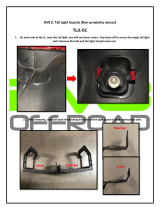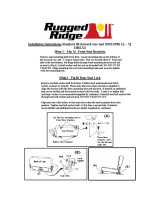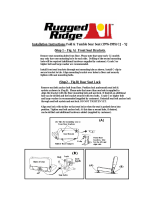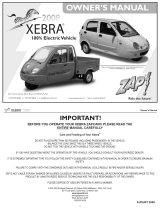
Foreword
Welcome to the growing group of value-conscious people who drive Toyotas. We are
proud of the advanced engineering and quality construction of each vehicle we build.
This Owner’s Manual explains the features of your new Toyota. Please read it and follow
the instructions carefully so that you can enjoy many years of safe motoring.
When it comes to service, remember that your Toyota dealer knows your vehicle best
and is interested in your complete satisfaction. He will provide quality maintenance and
any other assistance you may require.
Please leave this Owner’s Manual in this vehicle at the time of resale. The next
owner will need this information also.
All information and specifications in this manual are current at the time of
printing. However, because of Toyota’s policy of continual product improve-
ment, we reserve the right to make changes at any time without notice.
Please note that this manual applies to all models and explains all equipment,
including options. Therefore, you may find some explanations for equipment
not installed on your vehicle.
TOYOTA MOTOR CORPORATION
1996 TOYOTA MOTOR CORPORATION
All rights reserved. This material may not be reproduced or copied, in whole or in part,
without the written permission of Toyota Motor Corporation.

Your new vehicle is covered by the following Toyota
limited warranties:
For further information, please refer to the separate
“Owner’s Guide”, “Owner’s Manual Supplement” or
“Warranty Booklet”.
New vehicle warranty
Emission control systems warranty
Others
It is the owner’s responsibility to make sure that the
specified maintenance is performed. Part 6 gives de-
tails of these maintenance requirements. Also in-
cluded in Part 6 is general maintenance. For sched-
uled maintenance information, please refer to the
separate “Owner’s Manual Supplement/Mainte-
nance Schedule”.
A wide variety of non genuine spare parts and acces-
sories for Toyota vehicles are currently available in
the market. You should know that Toyota does not
warrant these products and is not responsible either
for their performance, repair or replacement, or for
any damage they may cause to, or adverse effect
they may have on, your Toyota vehicle.
This vehicle should not be modified with non genuine
Toyota products. Modification with non genuine Toyo-
ta products could affect its performance, safety or du-
rability, and may even violate governmental regula-
tions. In addition, damage or performance problems
resulting from the modification may not be covered
under warranty.
New vehicle warranty
Your responsibility for maintenance
Accessories, spare parts and
modification of your Toyota
The spark ignition system in your Toyota meets all re-
quirements of the Canadian Interference-Causing
Equipment Standard.
Spark ignition system of your Toyota

As the installation of a mobile two-way radio system
in your vehicle could affect electronic systems such
as multiport fuel injection system/sequential multiport
fuel injection system, cruise control system, anti-lock
brake system and SRS airbag system, be sure to
check with your Toyota dealer for precautionary mea-
sures or special instructions regarding installation.
The SRS airbag devices in your Toyota contains ex-
plosive chemicals. If the vehicle is scrapped with the
airbags left as they are, it may cause an accident such
as a fire. Be sure to have the SRS airbag system re-
moved and disposed of by a qualified service shop or
by your Toyota dealer before you dispose of your ve-
hicle.
Installation of a mobile
two-way radio system
Scrapping of your Toyota

2
Instrument panel overview

3

Without tachometer
4
Instrument cluster overview

With tachometer
5

6
Anti-lock brake system warning light *
1
Brake system warning light *
1
Seat belt reminder light*
1
Discharge warning light*
1
Low oil pressure warning light*
1
Malfunction indicator lamp*
1
Open door warning light*
1
SRS airbag warning light*
1
Turn signal indicator lights
Headlight high beam indicator light
Overdrive-off indicator light
Cruise control indicator light*
2
Rear window defogger indicator light
*
1
: For details, see “Service reminder indicators and warning
buzzers” in Chapter 1-5.
*
2
: If this light flashes, see “Cruise control” in Chapter 1-6.
Indicator symbols on the instrument panel

Part 1
Keys (sedan)
7
OPERATION OF
INSTRUMENTS
AND CONTROLS—
Chapter 1-2
Keys and Doors
Keys
Side doors
Power windows
Trunk lid
Back door
Hood
Theft deterrent system
Fuel tank cap
Electric sun roof
The master key works in every lock.
The subkey will not work in the trunk.
To protect things locked in the trunk when
you have your vehicle parked, leave the
subkey with the attendant.
Since the doors and trunk lid can be
locked without a key, you should always
carry a spare master key in case you acci-
dentally lock your keys inside the vehicle.
Keep the key number plate in a safe
place such as your wallet, not in the
vehicle.
If you should lose your keys or if you need
additional keys, duplicates can be made
by a Toyota dealer using the key number.
You should also put a copy of the key
number with your important papers.

8
The key works in every lock.
Since the side doors and back door can be
locked without a key, you should always
carry a spare master key in case you acci-
dentally lock your key inside the vehicle.
Keep the key number plate in a safe
place such as your wallet, not in the
vehicle.
If you should lose your keys or if you need
additional keys, duplicates can be made
by a Toyota dealer using the key number.
You should also put a copy of the key
number with your important papers.
LOCKING WITH KEY
Turn the key towards the front of the
vehicle to lock and towards the back to
unlock.
Vehicles with power door lock sys-
tem—All the side doors and back door
lock and unlock simultaneously with either
front door. In the driver’s door lock, turning
the key once will unlock the driver’s door
and twice in succession will unlock all the
side doors and back door simultaneously.
Keys (wagon)
Side doors

9
LOCKING WITH INSIDE LOCK BUTTON
Push in the lock button to lock and pull
it out to unlock.
Closing the door with the lock button
pushed in will also lock the door. Be care-
ful not to lock your keys in the vehicle.
LOCKING WITH POWER DOOR LOCK
SWITCH
To lock all the side doors simulta-
neously, push the switch on the LOCK
side. Pushing on the UNLOCK side
will unlock them.

10
LOCKING WITH REAR DOOR CHILD-
PROTECTOR
Turn the lock knob to the “LOCK”
position as shown on the label.
This feature allows you to lock a rear door
so it can be opened from the outside only,
not from inside. We recommend using this
feature whenever small children are in the
vehicle.
CAUTION
!
Before driving, be sure that the
doors are closed and locked, espe-
cially when small children are in the
vehicle. Along with the proper use of
seat belts, locking the doors helps
prevent the driver and passengers
from being thrown out from the ve-
hicle during an accident. It also
helps prevent the doors from being
opened unintentionally.
The windows can be operated with the
switch on each door.
The ignition key must be in the “ON” posi-
tion.
OPERATING THE DRIVER’S WINDOW
Use the switch on the driver’s door.
Normal operation: The window moves
as long as you hold the switch.
To open: Lightly push down the switch.
To close: Pull up the switch.
Power windows

11
Automatic operation (to open only):
Push the switch completely down and
then release it. The window will fully open.
To stop the window partway, lightly pull the
switch up and then release it.
OPERATING THE PASSENGERS’ WIN-
DOWS
Use the switch on each passenger’s
door or the switch on the driver’s door
that control each passenger’s window.
The window moves as long as you hold
the switch.
For driver and front passenger’s use—
To open: Push down the switch.
To close: Pull up the switch.
For rear passengers’ use-
To open: Push on the lower side of the
switch.
To close: Push on the upper side of the
switch.
If you push in the window lock button on
the driver’s door, the passenger’s win-
dows cannot be operated.

12
CAUTION
!
To avoid serious personal injury,
you must do the following.
Always make sure the head, hands
and other parts of the body of all oc-
cupants are kept completely inside
the vehicle before you close the
power windows. If someone’s neck,
head or hands gets caught in a clos-
ing window, it could result in a seri-
ous injury. When anyone closes the
power windows, be sure that they
operate the windows safely.
When small children are in the ve-
hicle, never let them use the power
window switches without supervi-
sion. Use the window lock button
to prevent them from making unex-
pected use of the switches.
Never leave small children alone in
the vehicle, especially with the
ignition key still inserted. They
could use the power window
switches and get trapped in a win-
dow. Unattended children can be-
come involved in serious acci-
dents.
To open the trunk lid from the outside,
insert the master key and turn it clock-
wise.
See ”Luggage stowage precautions” in
Part 2 for precautions to observe in load-
ing luggage.
To close the trunk lid, lower it and press
down on it. After closing the trunk lid, try
pulling it up to make sure it is securely
closed.
CAUTION
!
Keep the trunk lid closed while driv-
ing. This not only keeps the luggage
from being thrown out but also pre-
vents exhaust gases from entering
the vehicle.
To open the trunk lid from the driver’s
seat, pull up on the lock release lever.
Trunk lid (sedan)— —Lock release lever

13
This system deactivates the lock re-
lease lever so that things locked in the
trunk can be protected.
1. Push down the security lock levers
to lock the rear seatbacks.
On vehicles with built-in child restraint,
only the left seatback has a lock lever and
can be lowered. The right seatback can-
not be folded down.
After locking the rear seatbacks, try fold-
ing them down to make sure they are se-
curely locked, otherwise, someone could
get into the trunk by folding down a rear
seat.
2. After closing the trunk lid, insert the
master key and turn it counterclockwise
to deactivate the lock release lever.
After closing the trunk lid, try pulling it up
to make sure it is securely locked.
This system deactivates the lock re-
lease lever so that things locked in the
trunk can be protected.
After closing the trunk lid, insert the
master key and turn it counterclockwise
to deactviate the lock release lever.
After closing the trunk lid, try pulling it up
to make sure it is securely closed.
—Luggage security system
(with fold-down rear seat)
—Luggage security system
(without fold-down rear seat)

14
To open the back door from the out-
side, insert the key and turn it counter-
clockwise to unlock. Then pull the
handle and raise the back door.
See “Luggage stowage precautions” in
Part 2 for precautions to observe in load-
ing luggage.
To close the back door, lower it and press
down on it. After closing the back door, try
pulling it up to make sure it is securley
closed.
Keep the back door closed while
driving. This not only keeps the lug-
gage from being thrown out but also
prevents exhaust gases from enter-
ing the vehicle.
CAUTION
!
To lock the back door, push the switch
on the LOCK side. To unlock the back
door, push the switch on the UNLOCK
side.
You can, of course, lock and unlock the
back door manually.
To open the hood, pull the hood lock
release lever under the dash. The hood
will spring up slightly. In front of the
vehicle, press up on the auxiliary
catch lever and lift the hood. Then
hold the hood open by inserting the
support rod into the slot.
Before closing the hood, check to see that
you have not forgotten any tools, rags,
etc. and return the support rod to its
clip—this prevents rattles. Then lower the
hood and make sure it locks into place. If
necessary, press down gently on the front
edge to lock it.
After inserting the rod, make sure it
supports the hood securely.
CAUTION
!
—Locking with power back
door lock
HoodBack door (wagon)—

15
To deter the vehicle theft, the system is
designed to give an alarm and keep the
engine from being started if any of the
side doors, trunk lid, back door or hood
is forcibly unlocked or the battery ter-
minal is disconnected and then recon-
nected when the vehicle is locked.
The alarm blows the horn intermittently
and flashes the headlights, tail lights and
other exterior lights. The engine cannot
be started because the starter circuit will
be cut.
SETTING THE SYSTEM
1. Turn the ignition key to the ”LOCK”
position.
2. Have all passengers get out of the ve-
hicle.
3. Close and lock all the side doors, trunk
lid, back door and hood.
The indicator light will come on when all
the side doors, trunk lid, back door and
hood are closed and locked.
As the side doors are locked, the system
will give you a preparation time of 30 se-
conds before the setting, during which the
side doors, trunk lid, back door and hood
may be opened to prepare for the setting.
Be careful not to use the key when open-
ing either front door. This will cancel the
system.
Theft deterrent system

16
4. After making sure the indicator light
starts flashing, you may leave the vehicle.
The system will automatically be set after
the preparation time passes. The indica-
tor light will flash to show the system is
set. If any of the side doors, trunk lid, back
door or hood is open at that time, the set-
ting is interrupted until it is closed and
locked.
Never leave anyone in the vehicle when
you set the system, because unlocking
from the inside will activate the system.
WHEN THE SYSTEM IS SET
Activating the system
The system will give the alarm and cut the
starter circuit under the following condi-
tions:
If any of the side doors, trunk lid, back
door or hood is unlocked without using
the key
If the battery terminal is disconnected
and then reconnected
After 1 minute, the alarm will automatical-
ly stop with the starter circuit cut kept on.
Reactivating the alarm
Once set, the system automatically resets
the alarm each time alll the side doors,
trunk lid, back door and hood are closed
after the alarm stops.
The alarm will be activated again under
the following conditions:
If any of the side doors, trunk lid, back
door or hood is opened
If the battery terminal is disconnected
and then reconnected
Stopping the alarm
Turn the igniion key from the ”LOCK” to
”ACC” position. The alarm will be stopped
with the starter circuit cut kept on. Stop-
ping the alarm in this manner will keep the
alarm from being reactivated when any of
the side doors, trunk lid, back door or hood
is opened.
Interrupting the setting
With the system set, the trunk and back
door can be opened with the key without
activating or cancelling the system. While
it is open, the side doors and hood may be
opened in addition. However, when the
battery terminal is disconnected and then
reconnected, the system is activated.
To resume the setting, close and lock the
side doors, trunk, back door and hood.
The trunk and back door must be closed
with the key removed.
CANCELLING THE SYSTEM
Unlock either front door with the key. This
cancels the system completely and the
starter circuit cut will be cancelled at once.
INDICATOR LIGHT
The indicator light gives the following
three indications.
FLASHING—The system is set. You
need the key to open the side doors, trunk
lid , back door and hood.
ON—The system will automatically be set
when the time comes. The side doors,
trunk lid, back door and hood may be
opened without a key.
OFF—The system is inactive. You may
open any of the side doors, trunk lid, back
door or hood.
TESTING THE SYSTEM
1. Open all the windows.
2. Set the system as described above.
The front doors should be locked with the
key. Be sure to wait until the indicator light
starts flashing.
3. Unlock one of the side doors from the
inside. The system should activate the
alarm.
4. Cancel the system by unlocking either
front door with the key.
5. Repeat this operation for the other side
doors, trunk lid, back door and hood.
When testing on the hood, also check that
the system is activated when the battery
terminal is disconnected and then recon-
nected.
If the system does not work properly, have
it checked by your Toyota dealer.

17
1. To open the fuel filler door, pull the
lever up.
CAUTION
!
Do not smoke, cause sparks or al-
low open flames when refuelling.
The fumes are flammable.
When opening the cap, do not re-
move the cap quickly. In hot
weather, fuel under pressure
could cause injury by spraying
out of the filler neck if the cap is
suddenly removed.
2. To remove the fuel tank cap, turn
the cap slowly counterclockwise, then
pause slightly before removing it. Af-
ter removing the cap, hang it on the
cap hanger.
It is not unusual to hear a slight swoosh
when the cap is opened. When installing,
turn the cap clockwise till you hear a click.
CAUTION
!
Make sure the cap is tightened se-
curely to prevent fuel spillage in
case of an accident.
Use only a genuine Toyota fuel
tank cap for replacement. It has a
built in check valve to reduce fuel
tank vacuum.
Fuel tank cap Electric sun roof
Page is loading ...
Page is loading ...
Page is loading ...
Page is loading ...
Page is loading ...
Page is loading ...
Page is loading ...
Page is loading ...
Page is loading ...
Page is loading ...
Page is loading ...
Page is loading ...
Page is loading ...
Page is loading ...
Page is loading ...
Page is loading ...
Page is loading ...
Page is loading ...
Page is loading ...
Page is loading ...
Page is loading ...
Page is loading ...
Page is loading ...
Page is loading ...
Page is loading ...
Page is loading ...
Page is loading ...
Page is loading ...
Page is loading ...
Page is loading ...
Page is loading ...
Page is loading ...
Page is loading ...
Page is loading ...
Page is loading ...
Page is loading ...
Page is loading ...
Page is loading ...
Page is loading ...
Page is loading ...
Page is loading ...
Page is loading ...
Page is loading ...
Page is loading ...
Page is loading ...
Page is loading ...
Page is loading ...
Page is loading ...
Page is loading ...
Page is loading ...
Page is loading ...
Page is loading ...
Page is loading ...
Page is loading ...
Page is loading ...
Page is loading ...
Page is loading ...
Page is loading ...
Page is loading ...
Page is loading ...
Page is loading ...
Page is loading ...
Page is loading ...
Page is loading ...
Page is loading ...
Page is loading ...
Page is loading ...
Page is loading ...
Page is loading ...
Page is loading ...
Page is loading ...
Page is loading ...
Page is loading ...
Page is loading ...
Page is loading ...
Page is loading ...
Page is loading ...
Page is loading ...
Page is loading ...
Page is loading ...
Page is loading ...
Page is loading ...
Page is loading ...
Page is loading ...
Page is loading ...
Page is loading ...
Page is loading ...
Page is loading ...
Page is loading ...
Page is loading ...
Page is loading ...
Page is loading ...
Page is loading ...
Page is loading ...
Page is loading ...
Page is loading ...
Page is loading ...
Page is loading ...
Page is loading ...
Page is loading ...
Page is loading ...
Page is loading ...
Page is loading ...
Page is loading ...
Page is loading ...
Page is loading ...
Page is loading ...
Page is loading ...
Page is loading ...
Page is loading ...
Page is loading ...
Page is loading ...
Page is loading ...
Page is loading ...
Page is loading ...
Page is loading ...
Page is loading ...
Page is loading ...
Page is loading ...
Page is loading ...
Page is loading ...
Page is loading ...
Page is loading ...
Page is loading ...
Page is loading ...
Page is loading ...
Page is loading ...
Page is loading ...
Page is loading ...
Page is loading ...
Page is loading ...
Page is loading ...
Page is loading ...
Page is loading ...
Page is loading ...
Page is loading ...
Page is loading ...
Page is loading ...
Page is loading ...
Page is loading ...
Page is loading ...
Page is loading ...
Page is loading ...
Page is loading ...
Page is loading ...
Page is loading ...
Page is loading ...
Page is loading ...
Page is loading ...
Page is loading ...
Page is loading ...
Page is loading ...
Page is loading ...
Page is loading ...
Page is loading ...
Page is loading ...
Page is loading ...
Page is loading ...
Page is loading ...
Page is loading ...
Page is loading ...
Page is loading ...
Page is loading ...
Page is loading ...
Page is loading ...
Page is loading ...
Page is loading ...
Page is loading ...
Page is loading ...
Page is loading ...
Page is loading ...
Page is loading ...
Page is loading ...
Page is loading ...
Page is loading ...
/






